
Atrial Fibrillation- Management
.pdf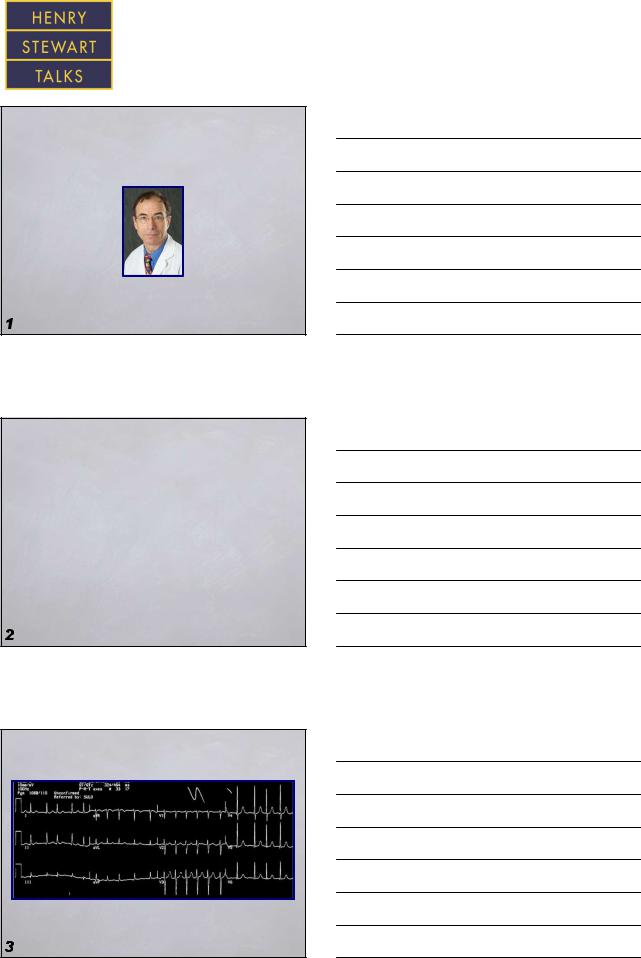
Atrial Fibrillation – Management
Brian Olshansky, MD
Atrial Fibrillation – Management
The Challenge and New Solutions
(Part 1 of 2)
Brian Olshansky, MD
Professor Emeritus of Medicine
University of Iowa Hospitals
72 yo female with palpitations
•CC: debilitating fatigue, dyspnea 2-3 times/day
•PMH: hypertension, diabetes
•Meds: metoprolol 25 mg bid
•Px: BP: 144/94, P: 120, irregular
–Lungs: clear
–Heart: normal S1 and S2
Electrocardiogram
The screen versions of these slides have full details of copyright and acknowledgements |
1 |

Atrial Fibrillation – Management
Brian Olshansky, MD
Echocardiogram
•Normal left ventricular function
•No valvular abnormalities
•LV wall thickness = 1.3 cm
•LA size = 4.2 cm
Event monitor
•Episodes of sinus rhythm
•Episodes of asymptomatic atrial fibrillation
•Episodes of rapid rates in atrial fibrillation during symptoms
Atrial fibrillation - classification
|
New/recurrent |
|
≥2 episodes |
Paroxysmal |
Persistent |
≤7 days |
>7 days |
Permanent
 Fuster V. Circulation 2006; 114:e257-e354
Fuster V. Circulation 2006; 114:e257-e354
The screen versions of these slides have full details of copyright and acknowledgements |
2 |

Atrial Fibrillation – Management
Brian Olshansky, MD
Why treat atrial fibrillation?
•Eliminate symptoms
•Reduce risk of stroke
•Reduce risk of heart failure
•Improve survival (?)
•Eliminate atrial fibrillation (?)
Treatment goals and strategies
|
Rate control |
Maintenance of SR |
Stroke prevention |
|
Pharmacologic |
Pharmacologic |
Nonpharmacologic |
Pharmacologic |
|
• |
Ca2+ blockers |
|
|
• Warfarin |
• |
β-blockers |
• Class IA |
• Catheter ablation |
• Aspirin |
• |
Digitalis |
• Thrombin Inhibitor |
||
• |
Amiodarone |
• Class IC |
• Pacing |
Nonpharmacologic |
Nonpharmacologic |
• Class III |
• Surgery |
• Removal/isolation |
|
• |
Ablate and pace |
• β-blocker |
• Implantable devices |
LA appendage |
|
Prevent remodeling |
• CCB |
|
|
|
|
• ACE-I, ARB |
|
|
• Statins
• Fish oil
Approach to treatment
Any (or all) may apply
•Anticoagulation
•Ventricular rate control
•Maintenance of sinus rhythm
The screen versions of these slides have full details of copyright and acknowledgements |
3 |
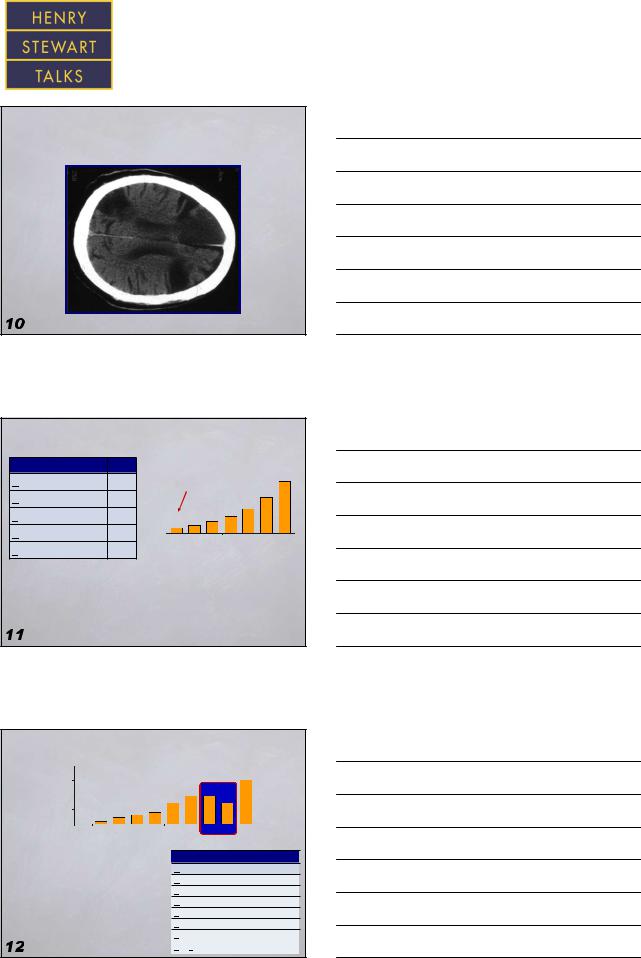
Atrial Fibrillation – Management
Brian Olshansky, MD
Patient with AF not anticoagulated
Complaint - dizziness
CHADS2 risk stratification
Risk factor |
Score |
Congestive heart failure |
1 |
HTN |
1 |
Age ≥75 y |
1 |
Diabetes |
1 |
Stroke |
2 |
Stroke rate, %
20 |
|
|
|
|
|
|
18.2 |
15 |
|
|
|
|
8.5 |
12.5 |
|
10 |
|
2.8 |
4.0 |
5.9 |
|
|
|
5 |
1.9 |
|
|
|
|||
0 |
0 |
1 |
2 |
3 |
4 |
5 |
6 |
|
|
|
CHADS2 score |
|
|
||
CHA2DS2-VASc now recommended
Rietbrock S. Am Heart J 2008; 156:57-64
Chugh SS. J Am Coll Cardiol 2001; 37:371-78
Rockson SG. J Am Coll Cardiol 2004; 43:929-935
CHA2S2-VASc risk stratification
% |
20 |
|
|
|
|
|
|
|
|
|
|
|
15.2 |
|
|
15 |
|
|
|
|
|
|
|
|
|
|
|
|
|
||
rate, |
|
|
|
|
|
|
|
|
9.8 |
9.6 |
|
|
|
|
|
10 |
|
|
|
|
|
|
6.7 |
6.7 |
|
|
|
||||
Stroke |
5 |
0 |
1.3 |
2.2 |
|
3.2 |
4.0 |
|
|
|
|
|
|
|
|
|
0 |
0 |
1 |
2 |
|
3 |
4 |
5 |
6 |
7 |
8 |
9 |
|
|
|
|
|
|
|
|
CHA2DS2-VAScscore |
|
|
|
|
|
|||||
• The CHA2DS2-VASc score |
|
|
|
Risk factor |
|
|
Score |
|
|||||||
|
|
|
|
|
|
||||||||||
|
|
|
Congestive heart failure |
1 |
|
||||||||||
and bleeding risk score overlap |
|
|
HTN |
|
|
|
1 |
|
|||||||
• Who should or should not |
|
|
|
|
Age ≥75 y |
|
|
2 |
|
||||||
get anticoagulants |
|
|
|
|
|
|
Diabetes |
|
|
|
1 |
|
|||
|
|
|
|
|
|
Stroke |
|
|
|
2 |
|
||||
– e.g. frailty in old age population |
|
|
Vascular disease |
|
1 |
|
|||||||||
(cost>benefit) |
|
|
|
|
|
|
Age 65-74 y |
|
|
1 |
|
||||
Lip GYH. Am J Med 2010; 123:484-488 |
|
|
|
Sex category (female) |
1 |
|
|||||||||
The screen versions of these slides have full details of copyright and acknowledgements |
4 |
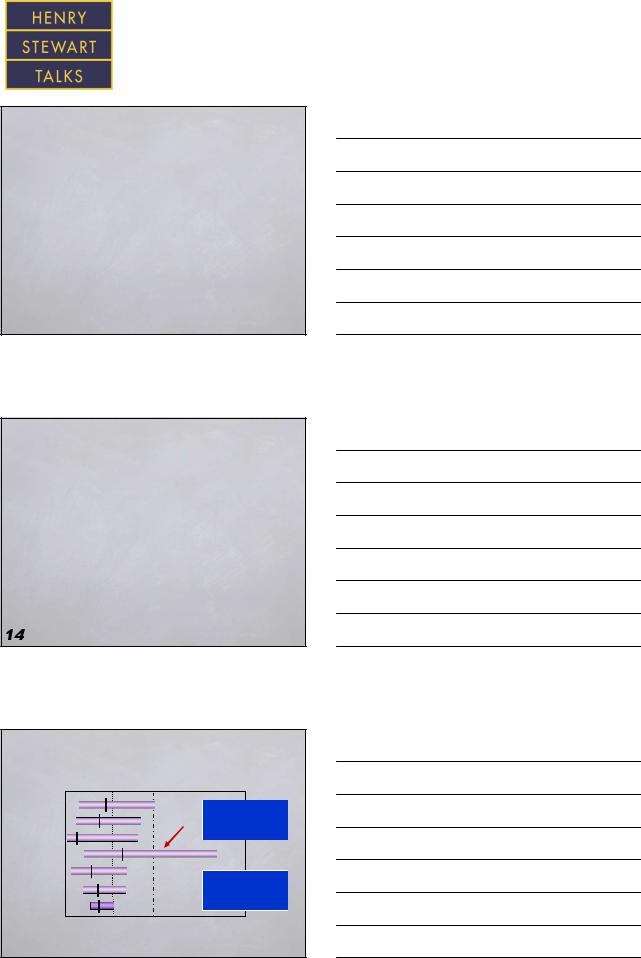
Atrial Fibrillation – Management
Brian Olshansky, MD
ASSERT trial
Subclinical atrial tachycardias and stroke
•Atrial tachycardia > 6 minutes, rate >190 bpm → greater risk for stroke
•2580 patients with pacemaker or ICDs
•Patients in the ASSERT trial with CHADS2 score of 1 with 1 event/year of AT/AF have 0.56 %/year – not enough for aggressive anticoagulation
 Healy J. New Engl J Med 2012; 366:120-129
Healy J. New Engl J Med 2012; 366:120-129
Warfarin
•The gold standard
•No one’s favorite drug
•Requires time in therapeutic range
•Gender differences exist
Warfarin anticoagulation in AF
|
Warfarin better |
|
Control better |
|
AFASAK |
|
|
|
Reduction of |
SPAF |
|
|
|
all-cause mortality |
BAATAF |
|
|
|
RRR 26% |
CAFA |
|
|
|
|
SPINAF |
|
|
|
Reduction |
EAFT |
|
|
|
of stroke |
Aggregate |
|
|
|
RRR 62% |
100% |
50% |
0 |
-50% |
-100% |
 Hart RG. Ann Intern Med 1999; 131:492-501
Hart RG. Ann Intern Med 1999; 131:492-501
The screen versions of these slides have full details of copyright and acknowledgements |
5 |
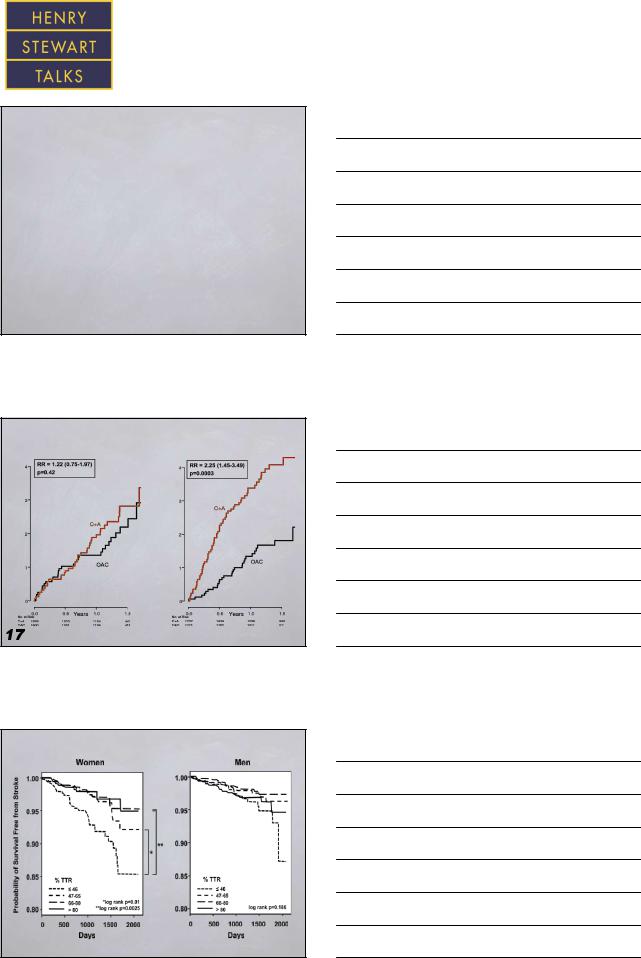
Atrial Fibrillation – Management
Brian Olshansky, MD
Warfarin – therapeutic range
•INR 2.0 - 3.0 = therapeutic range
•INR > 2 = risk of bleeding ↑, no reduction in risk for stroke
•INR < 2 = risk of stroke ↑↑
 Hylek EM. N Engl J Med 1996; 335:540–546
Hylek EM. N Engl J Med 1996; 335:540–546
Time in therapeutic range (TTR)
TTR<65% TTR≥65%
Thromboembolism % |
Thromboembolism % |
C+A = clopidogrel and aspirin
OAC = oral anticoagulation
Connolly S. Circulation. 2008; 118:2029-2037
AFFIRM - gender differences
 Sullivan RM. Am Heart J 2012 in press
Sullivan RM. Am Heart J 2012 in press
The screen versions of these slides have full details of copyright and acknowledgements |
6 |
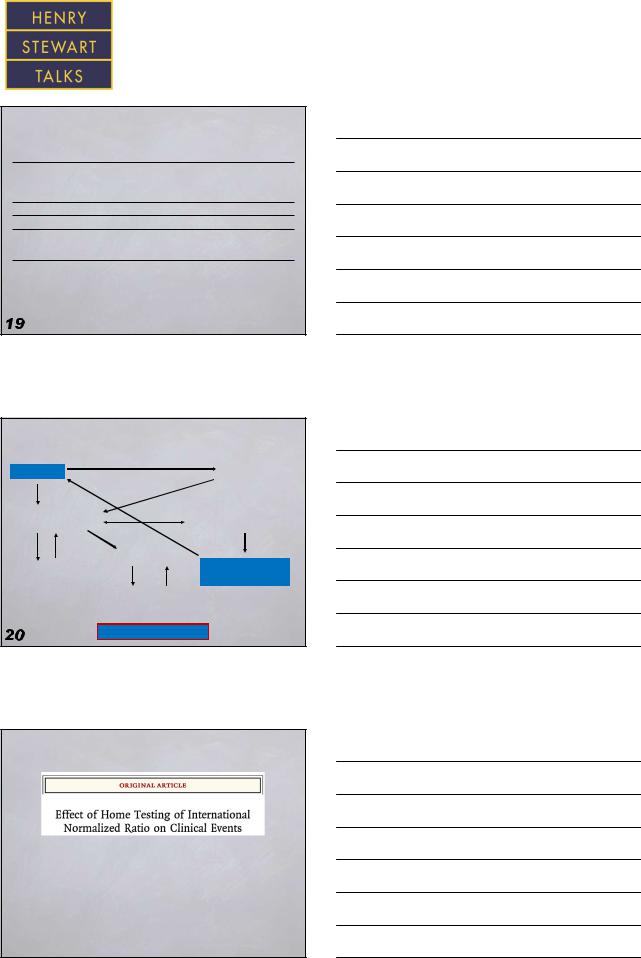
Atrial Fibrillation – Management
Brian Olshansky, MD
HAS-BLED bleeding risk score
Letter |
|
Clinical characteristic |
|
Points awarded |
|
|
|||
H |
|
Hypertension |
|
1 |
A |
|
Abnormal renal |
|
1 or 2 |
|
and liver function |
|
||
S |
|
Stroke |
|
1 |
B |
|
Bleeding |
|
1 |
L |
|
Labile INRs |
|
1 |
E |
|
Elderly (i.e., age >65 years) |
|
1 |
D |
|
Drugs or alcohol |
|
1 or 2 |
|
(1 point each) |
|
||
|
|
|
|
|
|
|
|
|
Maximum 9 points |
Pisters R. Chest 2010; 138:1093-1100 |
|
|
||
CammAJ. Eur Heart J 2010; 31:2369-2429 |
|
|
||
Traditional anticoagulation
Office visit |
Warfarin |
Send patient |
|
to lab for PT/INR |
|
Report data |
|
Patient contacted for |
by fax, phone |
dosage change, if needed |
|
Patient chart pulled |
|
Repeat sequence |
Nurse reviews data |
Data entered on chart |
every 1-8 weeks |
Warfarin is no one’s favorite drug
Is there a better way?
Is home monitoring the answer?
First event with home monitoring the same as clinic testing
 Matchar DB. N Engl J Med 2010; 363:1608-20
Matchar DB. N Engl J Med 2010; 363:1608-20
The screen versions of these slides have full details of copyright and acknowledgements |
7 |

Atrial Fibrillation – Management
Brian Olshansky, MD
Other anticoagulants
•Aspirin
•Clopidogrel (and in combination)
•Direct thrombin inhibitors (dabigatran)
•Direct factor Xa inhibitors
(rivaroxaban, apixaban, betrixaban, edoxaban)
ACTIVE trial
Clopidogrel plus aspirin combination was slightly better than aspirin alone
 Connolly S. N Engl J Med 2009; 360:2066-78
Connolly S. N Engl J Med 2009; 360:2066-78
Anticoagulation for AF and bleeding
Therapy |
HR (95% CI) |
Warfarin monotherapy |
1 [reference] |
Aspirin monotherapy |
0.93 (0.88-0.98) |
Clopidogrel monotherapy |
1.06 (0.87-1.29) |
Aspirin + clopidogrel |
1.66 (1.34-2.04) |
Warfarin + aspirin |
1.83 (1.72-1.96) |
Warfarin + clopidogrel |
3.08 (2.32-3.91) |
Triple therapy |
3.70 (2.89-4.76) |
 Hansen ML. Arch Intern Med 2010; 170:1433-1441
Hansen ML. Arch Intern Med 2010; 170:1433-1441
The screen versions of these slides have full details of copyright and acknowledgements |
8 |
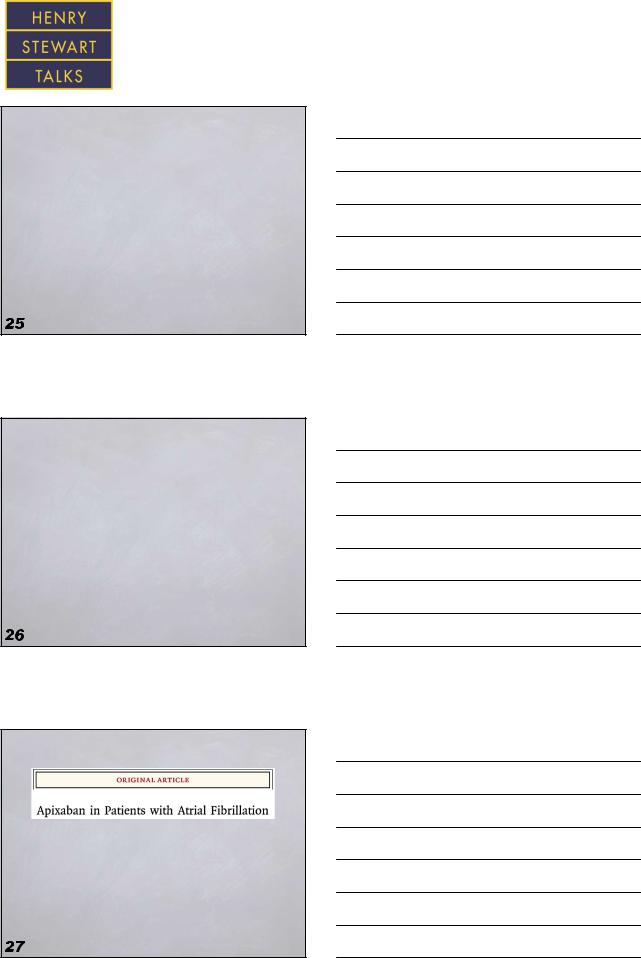
Atrial Fibrillation – Management
Brian Olshansky, MD
RE-LY: dabigatran
Connolly SJ. N Engl J Med 2009; 361:1139-1151
Mean CHADS2 – 2.1; TTR 64%
•Dabigatran 150 mg twice a day was associated with a lower risk for stroke and thromboembolism, compared to warfarin or 110 mg bid dose
•Dabigatran does not require measurements of an INR, it may be superior to warfarin
•Hard to determine the level of anticoagulation
•Risk of bleeding
•Expanse
ROCKET AF: rivaroxaban
Patel MR. N Engl J Med 2011; 365:883-891
•Rivaroxaban: 20 mg daily
•TTR 55%
•CHADS2 – 3.5
•There was no significant difference in the event rate over time (warfarin vs. rivaroxaban)
AVERROES: apixaban
Apixaban was superior to aspirin in terms of number of strokes or systemic embolic events in the long term follow up
Connolly S. N Engl J Med 2011; 364:806-17
The screen versions of these slides have full details of copyright and acknowledgements |
9 |

Atrial Fibrillation – Management
Brian Olshansky, MD
ARISTOTLE: apixaban
Granger CB. N Engl J Med 2011; 365:981-992
•Apixaban was superior in terms of the rate
of thromboembolic events, major bleeding events
•CHADS2 – 2.1
•Apixaban 5 mg bid
•TTR 62%
ACC/AHA guidelines
|
Risk category |
|
Recommendation |
|
|
|
|
||
|
|
|
Oral anticoagulantion recommended |
|
|
With prior stroke, TIA, |
|
(Warfarin IA, dabigatran, rivaroxaban, |
|
|
|
or apixaban IB) |
|
|
|
or CHA2DS2-VASc |
|
Direct thrombin or factor Xa inhibitor |
|
|
score ≥2 |
|
|
|
|
|
recommended if unable to maintain |
|
|
|
|
|
therapeutic INR I C |
|
|
With nonvalvular AF |
|
Reasonable to omit antithrombotic therapy |
|
|
and CHA2DS2-VASc |
|
|
|
|
score of 0 |
|
|
|
|
With nonvalvular AF |
|
No antithrombotic therapy or treatment |
|
|
and a CHA2DS2-VASc |
|
with oral anticoagulant or aspirin |
|
|
score of 1 |
|
may be considered |
|
 Fuster V. Circulation 2006; 114:e257-e354
Fuster V. Circulation 2006; 114:e257-e354
Anticoagulation – the bottom line
•Warfarin – gold standard, “high risk” patients
–Despite the fact that clinical trials show benefits of novel anticoagulants:
1.Long term experience
2.We can measure the level of anticoagulation
3.Less expensive
4.Renal/valvular heart disease issues
•“Risk” is still being refined
•Dabigatran or another drug may replace warfarin soon (even in lower risk patients)
The screen versions of these slides have full details of copyright and acknowledgements |
10 |
